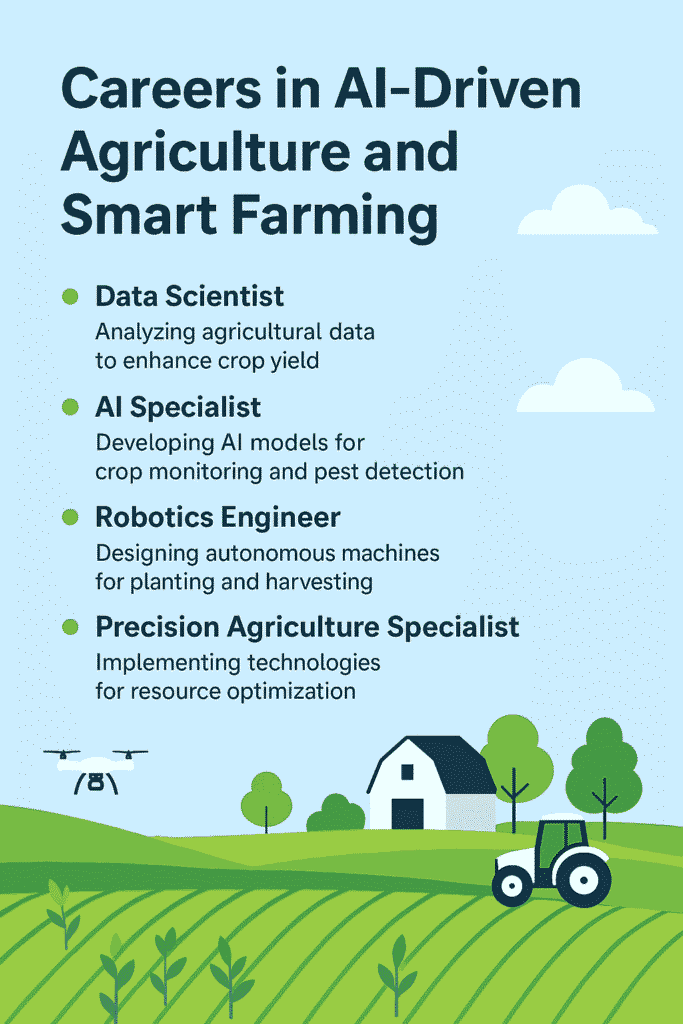Introduction
The world is facing multiple, intertwined challenges: growing population, climate change, depletion of natural resources, and the need for sustainable food production. Agriculture—once mostly traditional—is rapidly transforming. Technologies like Artificial Intelligence (AI), Internet of Things (IoT), robotics, drones, satellite imagery, precision farming systems, and data analytics are reshaping what farming means.
Smart farming, AI‑driven agriculture, precision agriculture—these concepts all point to a future where decisions on the farm are data‑informed, resource use is optimized, yield and input are balanced, environmental impact is minimized, and farmers, agribusinesses, governments, and consumers all benefit.
This shift is not just about tools; it’s about people. There is growing demand for professionals with hybrid skills: agriculture + technology, business + data, sustainability + innovation. This article explores the many possible careers in AI agriculture, what skills and education you need, what the trends are, the challenges, and what to expect in the future.
Table of Contents

What Is AI‑Driven Agriculture / Smart Farming?
Before diving into careers, let’s define what this domain covers. AI‑driven agriculture (often called agritech, smart farming, precision farming) refers to integrating advanced technologies into agricultural systems to:
- Collect data (soil, weather, crop health, pests, etc.) via sensors, drones, satellites, etc.
- Analyse that data using AI and machine learning to generate insights.
- Use robotics, automation, autonomous machinery to act on those insights.
- Optimize input use (water, fertilizer, pesticides), reduce waste, improve yields.
- Support decision‑making: when to sow, irrigate, harvest, etc.
- Make agriculture more sustainable, resilient to climate variability.
Key technologies include: AI / ML / deep learning, computer vision, IoT, remote sensing (satellite, drone), robotics, GIS (geographic information systems), cloud computing, big data, blockchain in some cases (for traceability).
Why Careers in AI Agriculture Are Growing
Multiple factors are driving growth in these sectors:
- Food demand & efficiency: With rising population, there’s need for higher yield and more efficient use of land, water, and nutrients.
- Climate challenges: Unpredictable weather, pest pressures, soil degradation demand resilient, responsive farming methods.
- Technology costs falling: Sensors, drones, data storage, cloud processing are more affordable, enabling adoption even by smallholders.
- Policy & sustainability: Governments, NGOs, consumers are pushing for environmental sustainability, traceability, low carbon emissions. Smart farming helps fulfill those demands.
- Data & automation trend: Across industries, AI and automation are becoming standard. Agriculture is catching up.
Hence, new jobs are being created; existing roles are evolving.
Main Career Roles & Paths in AI Agriculture
Here are many of the roles you can consider in AI‑driven agriculture / smart farming. Some are more technical, others more field‑/policy‑/business‑oriented.
| Role | What It Involves | Typical Duties | Who It Suits |
|---|---|---|---|
| Agri‑Data Scientist / AI Engineer | Building models using ML/AI to interpret agricultural data; predicting yields, pests, weather, optimizing resource use. | Collecting and cleaning data (soil, weather, satellite, drone), developing algorithms, training & validating ML models, deploying prediction pipelines, collaborating with agronomists. | Someone strong in programming, statistics, machine learning; also with interest in agriculture. |
| Computer Vision / Image Processing Specialist | Analysing images (drone, satellite, ground‑based cameras) to detect disease, pests, crop stress, weed infestations. | Building, training, deploying deep learning models to recognize patterns, automating detection, sometimes constructing datasets. | Interest in AI, image analysis; comfortable with deep learning frameworks; good with domain knowledge of plant pathology, etc. |
| IoT Engineer / Sensor Specialist | Setting up sensors and networks in fields / greenhouses; managing hardware, ensuring connectivity; capturing data. | Designing sensor systems (soil moisture, temperature, pH, etc.), installing devices, calibrating them, maintaining connectivity, data logging, edge computing. | People who like hardware + software; interest in field deployments; problem solving in noisy / imperfect environments. |
| Drone / UAV Operator & Aerial Imaging Analyst | Operating drones for imaging, mapping, spraying; analysing the images & data collected. | Flight planning, image capture, possibly autonomous flight; then processing the images (mapping, multispectral analysis, etc.). | Good for those who like robotics/hardware, outdoors; needs regulatory knowledge; sometimes need drone certification. |
| Precision Farming Specialist / Agronomist with Tech Skills | Integrating precision tools (variable rate tech, GPS, GIS, etc.) into farm operations; advising optimally. | Mapping soil zones; deciding fertilizer / seeding rates per zone; advising on irrigation; integrating sensor/drones data; working with farmers. | People with agriculture degrees who are open to tech; good communication; bridging between tech and farm. |
| Robotics / Automation Engineer | Designing and deploying robotic machinery/automated tools for tasks (weeding, harvesting, planting, etc.). | Mechanical/electrical/software design; integrating sensors, AI; prototyping; field testing, maintenance. | Engineers (mechanical, electrical, mechatronics), robotics enthusiasts; comfortable working in farms, labs. |
| GIS / Remote Sensing Specialist | Working with spatial data; mapping, analyzing satellite or aerial images; producing maps and spatial models. | Using GIS software, satellite/drone imagery; processing, geospatial modelling; perhaps integrating with climate data. | Someone strong in spatial analysis, remote sensing; interest in environment, mapping. |
| Farm Management / Agri‑Operations Manager (Tech‑Oriented) | Overseeing farm operations that integrate smart systems: ensuring sensor networks, automation, data feedback, etc., run well. | Planning crop cycles; integrating technologies; operating autonomous tools; coordinating labor and tech; cost management. | Good for people with agribusiness background + interest in tech; leadership, management. |
| Sustainability / Environmental Impact Analyst | Measuring and improving environmental impact: soil health, water use, carbon footprint. | Collecting environmental data; modelling; advising on sustainable inputs; regulatory compliance; sometimes policy. | Background in ecology/environment + agro; ability to work with data & policy. |
| Agritech Product Manager / Developer | Building products (apps, platforms) that enable smart farming: software tools, analytics dashboards, decision support systems. | Gathering user requirements (farmers, agronomists), overseeing product development cycles, UX, testing, launching, iterating. | Combination of tech (software) and domain knowledge; interest in user‑centred design; communication skills. |
| Supply Chain Traceability & Blockchain Expert | Ensuring that produce can be tracked from farm to consumer; using technologies like blockchain; ensuring quality, safety, compliance. | Designing systems that capture supply chain events; implementing traceability; compliance & auditing; possibly certifications. | People with background in agribusiness, logistics, software; interest in food safety, policy. |
| Policy / Consulting / Research | Advising governments/NGOs/funding agencies on smart farming strategies, developing research, performing pilot projects. | Researching, designing policy, analyzing impact, collaborating with stakeholders, running field trials. | Good for those who like broader view; strong communications; possibly academic background. |
| Agri‑Tech Entrepreneur / Innovator | Creating new solutions or startups: new hardware, software, platforms, services for farmers. | Ideation; prototyping; business model; pitching; working with users; scaling. | For people who like risk, innovation; cross‑disciplinary skills; understanding farmers’ pain points. |
Skills Required
Regardless of the specific role, several core skills and traits are in high demand. Many job listings, articles, and career guides highlight these. Rozgar Official Blog+3Cultor+3Fix My Career+3
Here are the key skill areas:
- Foundational Agriculture / Agronomy Knowledge
- Understanding plant biology, soil science, crop cycles, irrigation practices, pest & disease dynamics.
- Knowledge of farm management, economics of inputs and outputs.
This helps in making technology relevant and applicable. Without domain knowledge, many AI/tech solutions fail to translate into real value. Cultor+1
- Data Science & Analytics
- Data collection & processing: working with data from sensors, drones, satellites.
- Statistical analysis; familiarity with relevant software/tools (e.g. Python, R, SQL).
- Data cleaning, dealing with missing or noisy real‑world data.
- Visualization skills: dashboards, charts, maps.
- Predictive analytics: forecasting yields, disease risk, weather, etc. Cultor+2Fix My Career+2
- Machine Learning / AI / Deep Learning
- Algorithms: regression, classification, clustering, time series analysis.
- Deep learning, especially for image analysis (e.g. computer vision).
- Training, validating, deploying models; sometimes edge deployment (on devices) when cloud may not be feasible. arXiv+1
- Remote Sensing, GIS, and Computer Vision
- Interpreting satellite/drone imagery.
- Using GIS tools (QGIS, ArcGIS, etc.) for mapping and spatial analysis.
- Multispectral, hyperspectral imagery, NDVI, etc.
- Computer vision models for plant health/pest/disease detection. arXiv
- Hardware / IoT / Embedded Systems
- Soil moisture sensors, weather sensors, automated irrigation systems.
- Low‑power devices, connectivity (LoRa, NB‑IoT, etc.), edge computing.
- Drones, robots. Farmonaut®+2keymakr.com+2
- Software / Cloud / DevOps
- Cloud platforms (AWS, Azure, GCP) for data storage, computation, model deployment.
- APIs, backend/frontend development in case of product roles.
- Versioning, containerization (Docker), possibly CI/CD, monitoring deployed ML systems.
- Soft Skills & Domain Communication
- Ability to translate between technical teams and farmers / field staff.
- Problem solving; being able to identify real problems rather than tech for tech’s sake.
- Adaptability: field conditions are messy; network issues, data noise, hardware failures happen.
- Teamwork, cross‑disciplinary collaboration (with agronomists, environmental scientists, policy makers).
- Sustainability, Environmental Awareness, Ethics
- Understanding resource constraints (water, energy, land).
- Knowledge of sustainability practices.
- Ethical use of data, respecting privacy, ensuring smallholder farmers are not left behind.
- Regulations & Certifications (in certain roles)
- For drone operators, regulatory licenses.
- For food traceability, policy compliance.
- For environmental, safety standards.
- Continuous Learning Mindset
- The field is evolving quickly: new models, sensors, robotics.
- Being curious, keeping up with recent literature, new tools.
Education, Training & Learning Pathways
Here are typical educational and training routes, plus ways to build experience.
| Pathway | What to Study | Certifications / Courses | Gaining Experience |
|---|---|---|---|
| Undergraduate Degrees | Agriculture / Agronomy / Horticulture / Environmental Science; Agricultural Engineering; Computer Science / AI / Data Science. Some universities are offering blended/agritech‑oriented programs. | Degree itself, sometimes specializations (e.g. BSc in Agriculture with Agri‑Informatics) samglobaluniversity.ac.in | Internships, student research; working in farms / agritech startups. |
| Postgraduate / Master’s / PhD | Specialize in AI/ML, remote sensing, robotics, precision agriculture. | Fellowships, research assistant positions. | Projects involving field trials; collaborating with research labs or government agricultural research institutions. |
| Online & Short Courses / Certifications | AI, ML, data analytics; remote sensing / GIS; IoT; drone operation / aerial imaging. | Coursera, edX, Udacity; specialized agritech courses; certification for drones; AWS / cloud certificates. lspm.co.uk+1 | Apply learning to small projects; build a portfolio (e.g. crop disease detection system; sensor data dashboards). |
| Bootcamps / Workshops | Hands‑on learning on computing, hardware, robotics, drone flying, field data collection. | Workshops, hackathons, agricultural innovation challenges. | Participate in pilot projects; network with startups; field exposure. |
| On‑job / Apprenticeship | Many agri‑tech companies look for interns, junior data roles, field technician roles. | Learning while working; mentorship. | Valuable exposure; builds domain understanding. |
Geographic & Sectoral Variations
The demand, roles, salaries etc. vary depending on region (country, rural vs urban), farm size (small, medium, large), climate, government policy.
- In India, for example, there is rising interest in smart farming, precision agriculture, supported by government policies. Courses in smart agriculture have practical salaries; roles like agricultural AI specialist, soil & climate analyst are becoming more common. samglobaluniversity.ac.in
- In more developed agricultural economies, large farms or agribusinesses have the resources for robotics, drones, automation; smaller farms often adopt more modest tech (sensor kits, advisory apps).
- Sectors: crops vs livestock vs fisheries vs controlled‑environment agriculture (greenhouses, vertical farming). Each domain has different specific challenges and roles.
Examples of Specific Job Titles & What They Pay / Opportunities
Here are some job titles you may find, with examples of what their duties are, and (where available) salary expectations or scale, especially in India. Salaries are illustrative, subject to experience, location, employer.
| Job Title | Responsibilities | Approx Salary / Range in India* / Other Notes |
|---|---|---|
| Agricultural Data Analyst | Handling data from sensors/drones, generating reports, visualizing yields, giving recommendations. | ~ ₹5–₹12 Lakh per annum depending on experience. samglobaluniversity.ac.in |
| Precision Farming Specialist | Managing GPS tools, variable rate tech; mapping fields; advising input use. | ~ ₹4–₹8 LPA in some roles. samglobaluniversity.ac.in |
| Agri‑Tech App Developer | Building apps for decision support, connecting farmers to advisory + market. | ~ ₹6–₹15 LPA in some cases. samglobaluniversity.ac.in |
| Drone Operator / Technician | Flying drones, doing imagery, perhaps spraying, maintaining equipment. | ~ ₹3–₹7 LPA. samglobaluniversity.ac.in |
| Soil & Climate Analyst | Analysing soil data, weather modelling, advising on input and risk. | ~ ₹4–₹9 LPA (India) for junior roles. samglobaluniversity.ac.in |
| Agricultural AI Specialist / ML Engineer (Agri) | Building predictive models (disease, yield, etc.), developing AI systems for farms. | ~ ₹7–₹16 LPA (India) for promising roles. samglobaluniversity.ac.in |
* These are approximate ranges for India; seniority, employer type (startup vs big company), region will affect drastically.
Also in many international settings, salaries are higher; roles in R&D or global agritech firms may pay considerably more.
Emerging Trends & Growth Areas
To plan a career, it’s helpful to know what’s rising. Here are the trends to watch:
- Vertical / Controlled‑Environment Farming
Growing crops in greenhouses, vertical farms, indoor farms—with AI controlling lighting, temperature, humidity, nutrients. Smaller land usage, more control, possibility for year‑round production. Deep learning, robotics, sensors are important here. arXiv - Autonomous Robotics & Machinery
Autonomous tractors, robot harvesters, weeders. Robots that can navigate fields, avoid obstacles, identify ripe produce, etc. Lower manual labor, higher precision. Farmonaut®+1 - Edge Computing
Because connectivity and bandwidth are challenges in rural / field settings, pushing computation (or partial computation) to devices (“edge”) is being actively researched. Low latency, reduced data transmission, power constraints. arXiv - Multimodal & Multi‑Source Sensing
Combining data from soil sensors, drones, weather stations, satellites, even foot traffic, to produce richer models. Also using different modalities (images, spectral data, temperature, humidity). arXiv+1 - Explainable AI, Domain Adaptable Models
Farmers / agronomists want to understand AI model’s reasoning; models robust to different climates, soil types, etc. Transfer learning; domain adaptation; models that are interpretable. arXiv - Sustainability & Climate Resilience
Focus on water conservation, soil health, biodiversity; adapting to changing climate; reducing agrochemical usage. AI can help optimize resource use and forecast risks. Farmonaut®+1 - Policy & Traceability Technologies
Food safety, supply chain transparency (blockchain / digital traceability), certifications. Consumers increasingly demand knowledge of where food comes from, how produced. Farmonaut® - Farmer Advisory / Decision Support Platforms
Apps, dashboards, mobile based advisory tools that use AI to give real‑time or near‑real‑time recommendations (pest alerts; irrigation scheduling; fertilizer application). Farmonaut®+1
Challenges & Things to Keep in Mind
While opportunities are many, there are also real challenges. Being aware of them helps in choosing roles, being realistic, preparing better.
- Data Quality & Availability: Collecting consistent, reliable data from real farms is hard. Sensors can fail; data may be noisy; metadata (context) often missing.
- Generalization / Domain Adaptation: Models built in one climate, soil type, farm scale may not work in others.
- Infrastructure: In many rural areas, internet / power support may be weak; sensors might not be maintained; costs of equipment may be high.
- Farmer Adoption & Trust: Farmers may be skeptical; cost, complexity, lack of training can be barriers. Solutions have to be usable, understandable.
- Regulation & Policy: Drone laws, data privacy, environmental regulations can slow adoption.
- Cost: Upfront cost for hardware (drones, sensors, robotics) is high; ROI may be long.
- Skill Gap: People with pure agriculture or pure tech may struggle. Bridging the gap is essential.
- Sustainability / Ethical Concerns: Over‑reliance on high‑tech can marginalize smallholders; digital divide; environmental impact of tech (materials, energy use).
- Risk & Uncertainty: Weather events, pests, market fluctuations are unpredictable; models may fail; risk‑management must be part of solution.
How to Prepare Yourself for a Career in AI‑Driven Agriculture
Here’s a step‑by‑step guide / checklist to position yourself for these roles.
- Decide where you want to be
Do you like working outdoors / in fields? Do you prefer research / labs / computers? Do you want to build hardware, software, or manage operations or policy? This shapes which roles you aim for. - Get relevant education
- Start with degree in agriculture / agronomy / environmental science / agricultural engineering / computer science / data science etc.
- Supplement with specialized courses: remote sensing, GIS, ML, robotics, etc.
- Build technical skills
- Learn programming: Python is almost essential; R, perhaps MATLAB.
- Machine learning, deep learning frameworks: TensorFlow, PyTorch, Scikit‑learn.
- GIS / remote sensing tools: QGIS, ArcGIS, satellite data processing tools.
- Hardware / IoT basics: understanding sensors, connectivity, embedded programming.
- Cloud / edge computing basics.
- Gain field exposure
- Internships with agritech startups, research organizations, government agricultural extensions.
- Participate in pilot projects: data collection, sensor installation, drone flying, field trials.
- Work with farmers, agronomists to understand real pain points, constraints.
- Build a portfolio / projects
- Build small models: crop disease detection, yield prediction, soil moisture prediction, etc.
- Use public datasets, or collect your own.
- If possible, create apps or dashboards; demonstrate end‑to‑end workflows.
- Networking & Collaboration
- Join agritech communities, forums, research groups.
- Attend conferences/workshops (online or offline).
- Collaborate across disciplines: agriculture, data science, engineering, environment.
- Stay updated / continuous learning
- Follow recent research (journals, preprints). For example, papers on AI in crops, livestock, remote sensing. arXiv+1
- Learn about new hardware, regulation, drone laws etc.
- Consider specialization
- For example: computer vision for disease detection; robots; controlled environment agriculture; policy; sustainability metrics; supply chain traceability.
- Soft skills & mindset
- Communication: You often act as a bridge between tech teams and non‑tech stakeholders (farmers, policy, business).
- Empathy: Understanding real agricultural challenges (climate, economics).
- Problem framing: Not every problem needs AI; being able to decide when AI is appropriate.
- Resilience: Field conditions are imperfect; prototypes often fail; debugging hardware/software in unpredictable settings.
Some Illustrations / Case Studies
Here are a few examples (real or hypothetical) of how careers / projects in this field look in practice. (Some drawn from literature or news.)
- Autonomous Ground Rover “AGRO”: A project that uses an unmanned ground vehicle equipped with sensors + ML + real‑time mapping to estimate yields (e.g. pistachio) and navigate fields autonomously, avoiding obstacles. Such projects require interdisciplinary teams: robotics, computer vision, field agronomy. arXiv
- Vertical Farming + AI: Controlled environment agriculture uses AI to control lighting, humidity, nutrients etc., to optimize growth, reduce water usage, energy use. Specialists in AI, sensors, hardware, environmental control are critical. arXiv
- Smart pest / disease monitoring: Drones or fixed cameras capture images; AI models detect early pest infestations; alert farmers; reduce pesticide use; can prevent crop loss. These roles often involve image analysts, ML engineers, agronomists.
- Government / Policy Initiatives: For example, programs to integrate AI into agriculture extension services; funding / grants for research centers; supporting startups; shaping drone regulation / data privacy / environmental regulation. Roles here include policy analysts, advisors, researchers. In India, there are Centre of Excellence (CoE) being set up to enhance agricultural practices using AI, ML. The Times of India
What Employers Are Looking For
Employers hiring for roles in AI / smart farming typically value:
- Relevant experience: Internships, practical projects in agriculture technology.
- Hybrid understanding: Some background in agriculture + technology. Even if your degree is tech, experience / exposure to agronomy helps.
- Ability to work in imperfect environments: Field data is messy; connectivity, power, weather, hardware may all be less reliable.
- Self‑starter mindset: Many agri‑tech companies are startups; roles may require flexibility, wearing many hats.
- Communication skills: Explaining technical findings to non‑technical users (e.g. farmers); getting feedback; co‑designing tools.
- Understanding of business / ROI: Tech is only valuable if it helps reduce costs, increase yield, improve sustainability. Employers want people who can think in terms of return, not just models.
Potential Salary & Growth
While exact salaries can vary widely depending on country, organization type, seniority, etc., here are trends:
- Entry‑level roles (junior data analyst, junior agronomist with tech) typically have modest pay, especially in developing countries. As experience grows, salary increases with specialization (ML, robotics, product management).
- Over time, senior roles (lead AI engineer, research scientist, product lead) can command high pay, especially in international / export‑oriented agritech firms or companies with R&D budgets.
- Non‑monetary benefits are also increasing: roles that offer meaningful impact, working with sustainability, being part of innovative tech.
Outlook: What the Future Holds
Looking ahead, here are the things likely to shape this field, which also suggest how careers will evolve.
- More integration & automation: Autonomous machines will become more common; robotics will handle more farm tasks.
- AI at the edge & real‑time decision making: Systems will become more real‑time; sensor networks + local computation; less dependency on always‑on internet.
- Better models, more data, domain adaptation: Models trained with more and better data (from many geographies), with ability to adapt to local conditions.
- Greater focus on sustainability & climate resilience: Roles specialized in climate risk analysis, carbon accounting, soil health, water footprint.
- Democratization of tools: Lower cost sensors, cheaper drones, open source models; more farmers/smallholders able to use tools; more roles in extension & advisory.
- Policy, regulation, ethics will matter more: Data privacy; drone regulation; trade & export regulations; environmental laws. People who understand both tech & regulation will be in demand.
- Interdisciplinary / cross‑sector roles: Roles blending biology, data science, hardware, business, policy. People who can cross boundaries will have advantage.
- Growing startup ecosystem & investment: More investment in agritech; more startups; more room for entrepreneurship.
Suggested Roadmap for Someone Starting Out
If you are a student / early career professional interested in this field, here’s a suggested roadmap:
- Foundation (Year 1‑2)
- Build strong basics: either agriculture/agronomy or in computing / data science.
- Take complementary courses (if agriculture student, learn some programming / data science; if tech field, learn some agronomy).
- Do small projects (sensor data, crop disease datasets etc.).
- Intermediate (Year 3‑4)
- Internships with agritech companies / research labs.
- Projects that involve real field data.
- Possibly specialize according to interest (computer vision, robotics, remote sensing, etc.).
- Build portfolio or contribute to open source / research.
- Advanced / Mid‑Career
- Take leadership roles; product development; combining tech & business.
- Possibly pursue research (Master’s / PhD) depending on interest.
- Evaluate starting or joining startups; perhaps policy, consulting roles.
- Continuous Learning / Diversification
- Stay current with new sensors, AI methods, hardware.
- Understand emerging regulatory or environmental issues.
- Possibly pick up skills in adjacent domains (climate science, sustainability, supply chain).
Global & Local Stories / Examples
Including concrete examples helps illustrate possibilities and inspire decisions.
- India’s Agri‑AI Centers: For example, IIT Indore has set up an Agri Hub, a Centre of Excellence to develop tech solutions integrating AI, ML, deep learning to convert agricultural data into actionable insights. The Times of India
- Government policies: e.g. “MahaAgri‑AI Policy 2025‑2029” in Maharashtra (India) allocating funds for deploying AI and modern technologies (drones, sensors, mobile apps) to assist farmers with real‑time monitoring, market analytics, pest control etc. The Times of India
- SwagBot: AI‑powered robot cattle herder that assesses pastures, moves livestock optimally to avoid overgrazing, supports pasture health. A robotics / AI‑in‑livestock example. Reuters
These demonstrate that opportunities are not just theoretical—they’re happening now.
follow us on whatsapp channel

















